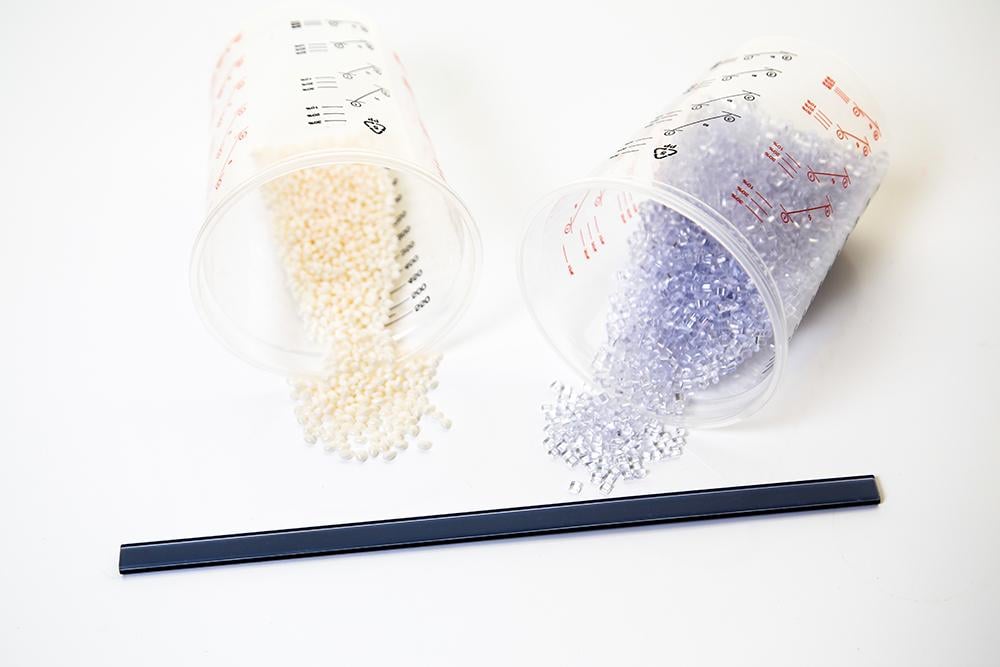Beyond Aircraft Recycling Strategies, Bioadditives Show Promise

STG Aerospace is using bioadditives in its saf-Tglo eco e1 emergency floor path markings that allow the product to biodegrade once it is in a landfill.
End-of-life and product circularity are top-of-mind within the aftermarket as increasing scrutiny is placed on the recycling or disposal of everything removed from the aircraft—whether during a refurbishment or at the end of an airframe’s life. Suppliers seek system and technology solutions, and non-electric emergency floor path markings are a useful case study.
One option is recycling, where Lufthansa Technik (LHT) is using circular economy principles and a take-back commitment for its GuideU system.
“The GuideU circular journey collection point plan is a strategic initiative, [for the] first time in the industry for cabin interior, that embodies key principles of the circular economy and innovation,” says Christopher Bellieno, senior product manager at LHT.
LHT’s goals are long-term resilience and value retention of the units. “By collecting and refurbishing GuideU units, we're extending product lifecycles and reducing waste,” says Bellieno. In addition, the “closed-loop system … creates a circular flow of materials, keeping resources in use for as long as possible,” he adds.
A key challenge here is reverse logistics, especially around collecting used GuideU units. Initially, the plan is to start with Airbus facilities in Toulouse and Hamburg, plus LHT’s European Union locations. Further afield, airlines can return the material to the company’s logistics centers, with wider participation planned.
“The insights gained will directly influence our product development in the coming years, creating a feedback loop that enhances sustainability and circularity,” Bellieno says.
LHT is studying the carbon accounting implications for the circular journey initiative and expects to have more concrete data in 2025.
STG Aerospace is taking a different approach for its saf-Tglo eco E1 product: designing it to biodegrade in a landfill.
“We have no control over the end of life of our product,” says Tracy Vyas-Middlecoat, STG Aerospace’s research and development scientist. “We would love everyone to recycle their products, but we know that the majority of consumers will remove it from the aircraft and put it into a landfill. We wanted to cover all bases and utilize something that would not leave a trace, no matter what the disposal route.”
The fundamental problem the industry is trying to solve is preventing non-biodegradable plastics from ending up in landfills, breaking down very slowly and releasing harmful microplastics into the environment, including into water supplies and the food chain.
According to Vyas-Middlecoat, STG’s solution “breaks down into water, carbon dioxide, biomass and methane. The first three can be released into the environment to be used in animal and plant lifecycles. Methane is a standard byproduct of landfill environments and is a greenhouse gas. However, many landfills are now being set up to capture this methane, which can then be recycled into biogas to be used as fuel.”
The additive requires an active microbial atmosphere to work—for example, a landfill. In these conditions, microbes are attracted to the additive within the plastic and create a biofilm around it. They secrete enzymes that generate a catalyst for the breakdown of the complex polymer chains that make up these kinds of plastics.
“The time frame for biodegradation is influenced by the dosage of the bioadditive in the plastic, as well as the type, thickness and molecular weight of the polymer,” Vyas-Middlecoat explains. “For effective biodegradation, the polymer product must be disposed of in an active microbial environment, such as landfills, marine environments or nutrient-rich agricultural soil. It is important to note that products containing the additive will not begin to decompose while stored on a warehouse shelf or in service; the presence of an active microbial environment is essential for initiating the process.”
During the manufacturing process, the bioadditive (in pellet form) is added to the base polycarbonate during the extrusion process, creating a homogenous mix that performs in all other ways—including in recycling—as the product without the additive. STG is also working on the carbon accounting for the product, but all signs point towards a strong net positive.
“It is likely to be categorized as Scope 3 Indirect emissions for end-of-life treatment of sold products,” Vyas-Middlecoat says. “Plastic products with the additive are safe for the recycling stream, and the use of the additive does not change the recycling designation of the final product. The methane produced from the biodegradation of the product can also be captured and reused in other applications.”




